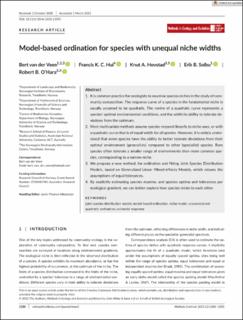| dc.contributor.author | van der Veen, Bert | |
| dc.contributor.author | Hui, Francis K. C. | |
| dc.contributor.author | Hovstad, Knut Anders | |
| dc.contributor.author | Solbu, Erik Blystad | |
| dc.contributor.author | OHara, Robert Brian | |
| dc.date.accessioned | 2021-10-22T11:57:31Z | |
| dc.date.available | 2021-10-22T11:57:31Z | |
| dc.date.created | 2021-06-28T19:26:47Z | |
| dc.date.issued | 2021-03-25 | |
| dc.identifier.citation | Methods in Ecology and Evolution. 2021, 12 (7), 1288-1300. | en_US |
| dc.identifier.issn | 2041-210X | |
| dc.identifier.uri | https://hdl.handle.net/11250/2825006 | |
| dc.description.abstract | 1. It is common practice for ecologists to examine species niches in the study of community composition. The response curve of a species in the fundamental niche is usually assumed to be quadratic. The centre of a quadratic curve represents a species' optimal environmental conditions, and the width its ability to tolerate deviations from the optimum. 2. Most multivariate methods assume species respond linearly to niche axes, or with a quadratic curve that is of equal width for all species. However, it is widely understood that some species have the ability to better tolerate deviations from their optimal environment (generalists) compared to other (specialist) species. Rare species often tolerate a smaller range of environments than more common species, corresponding to a narrow niche. 3. We propose a new method, for ordination and fitting Joint Species Distribution Models, based on Generalized Linear Mixed-effects Models, which relaxes the assumptions of equal tolerances. 4. By explicitly estimating species maxima, and species optima and tolerances per ecological gradient, we can better explore how species relate to each other. | en_US |
| dc.language.iso | eng | en_US |
| dc.publisher | John Wiley & Sons Ltd. | en_US |
| dc.rights | Navngivelse 4.0 Internasjonal | * |
| dc.rights.uri | http://creativecommons.org/licenses/by/4.0/deed.no | * |
| dc.title | Model-based ordination for species with unequal niche widths | en_US |
| dc.type | Peer reviewed | en_US |
| dc.type | Journal article | en_US |
| dc.description.version | publishedVersion | en_US |
| dc.rights.holder | © 2021 The Authors | en_US |
| dc.source.pagenumber | 1288-1300 | en_US |
| dc.source.volume | 12 | en_US |
| dc.source.journal | Methods in Ecology and Evolution | en_US |
| dc.source.issue | 7 | en_US |
| dc.identifier.doi | 10.1111/2041-210X.13595 | |
| dc.identifier.cristin | 1919120 | |
| dc.relation.project | Norges forskningsråd: 272408 | en_US |
| cristin.ispublished | true | |
| cristin.fulltext | original | |
| cristin.qualitycode | 2 | |

